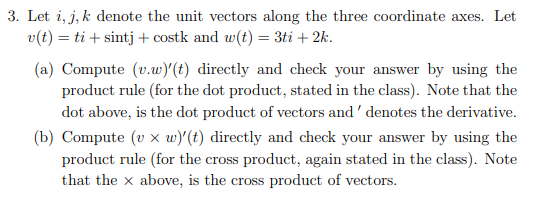3. Let i, j, k denote the unit vectors along the three coordinate axes. Let v(t) = ti + sintj + costk and w(t) = 3ti + 2k. (a) Compute (v.w)'(t) directly and check your answer by using the product rule (for the dot product, stated in the class). Note that the dot above, is the dot product of vectors and' denotes the derivative. (b) Compute (vx w)'(t) directly and check your answer by using the product rule (for the cross product, again stated in the class). Note that the x above, is the cross product of vectors.
3. Let i, j, k denote the unit vectors along the three coordinate axes. Let v(t) = ti + sintj + costk and w(t) = 3ti + 2k. (a) Compute (v.w)'(t) directly and check your answer by using the product rule (for the dot product, stated in the class). Note that the dot above, is the dot product of vectors and' denotes the derivative. (b) Compute (vx w)'(t) directly and check your answer by using the product rule (for the cross product, again stated in the class). Note that the x above, is the cross product of vectors.
Algebra & Trigonometry with Analytic Geometry
13th Edition
ISBN:9781133382119
Author:Swokowski
Publisher:Swokowski
Chapter8: Applications Of Trigonometry
Section8.4: The Dot Product
Problem 12E
Related questions
Question

Transcribed Image Text:3. Let i, j, k denote the unit vectors along the three coordinate axes. Let
v(t) = ti+ sintj + costk and w(t) = 3ti + 2k.
(a) Compute (v.w)' (t) directly and check your answer by using the
product rule (for the dot product, stated in the class). Note that the
dot above, is the dot product of vectors and denotes the derivative.
(b) Compute (v x w)'(t) directly and check your answer by using the
product rule (for the cross product, again stated in the class). Note
that the x above, is the cross product of vectors.
Expert Solution
This question has been solved!
Explore an expertly crafted, step-by-step solution for a thorough understanding of key concepts.
This is a popular solution!
Trending now
This is a popular solution!
Step by step
Solved in 5 steps

Follow-up Questions
Read through expert solutions to related follow-up questions below.
Follow-up Question
can you show how do you calculate for these two parts?

Transcribed Image Text:=(i + (cos t)j + (− sin t)k) × ((3t)i + 2k) + ((t)i + (sin t)j + (cos t)) × (3i + 0k)
i
j
ki
j
k
cos tsin t+t
sin t
1
3t 0
2
3 0 0
=(2 cos t)i + (−2 − 3t sin t)j + (−3t cos t)k + 0i+ (3 cos t)j + (−3 sin t)k
cos t

Transcribed Image Text:Since,
v (t) x w (t)=((t)i
+ (sin t)j + (cos t)k) x ((3t)i + 2k)
k
i
t
cos t
3t 0
2
=(2 sin t)i + (3t cos t − 2t)j + (−3t sin t)k
j
sint
Solution
Recommended textbooks for you

Algebra & Trigonometry with Analytic Geometry
Algebra
ISBN:
9781133382119
Author:
Swokowski
Publisher:
Cengage

Algebra & Trigonometry with Analytic Geometry
Algebra
ISBN:
9781133382119
Author:
Swokowski
Publisher:
Cengage